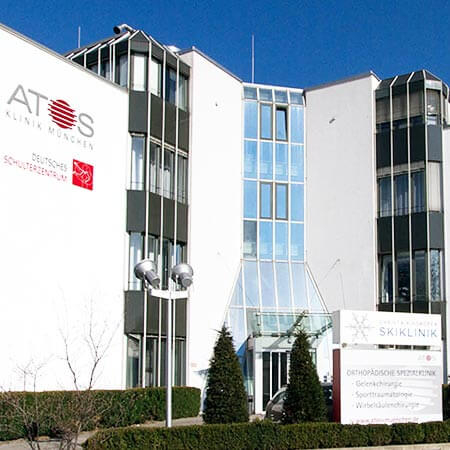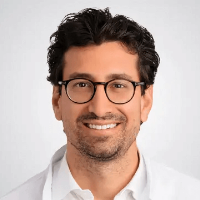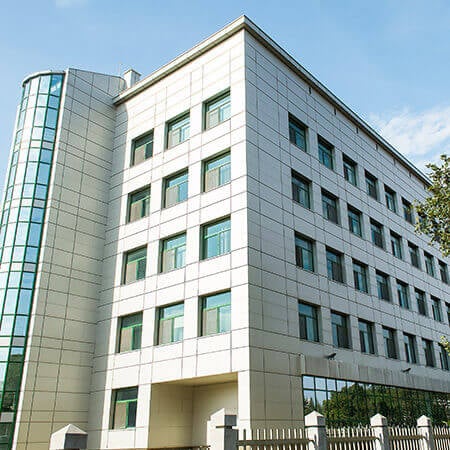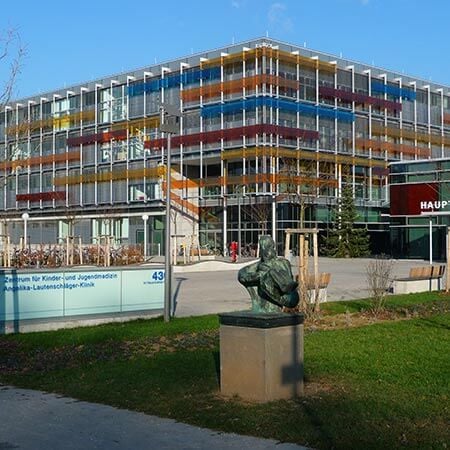Elbow Arthritis — Total Elbow Replacement: treatment in the Best Hospitals in the World
Treatment prices are regulated by national law of the corresponding countries, but can also include additional hospital coefficients. In order to receive the individual cost calculation, please send us the request and medical records.

Department of Orthopedics, Foot Surgery, Hand Surgery and Spinal Surgery
According to the prestigious medical magazine Focus, the Department of Orthopedics, Foot Surgery, Hand Surgery and Spinal Surgery is one of the best medical facilities in Germany, specializing in shoulder and knee surgery, foot surgery, and hand surgery! The department offers a full range of medical services for diseases of the musculoskeletal system. The key focus of the department's doctors is the treatment of diseases of the large joints: knee, hip, shoulder, elbow, ankle, and wrist. Foot surgery specialists are responsible for the correction of hallux valgus, hallux rigidus, clubfoot, flatfoot, and claw toes, as well as the treatment of ankle arthrosis, heel spurs, and Achilles tendon ruptures. The department regularly admits patients with hand diseases, with particular interest in the treatment of wrist arthrosis, rhizarthrosis, carpal tunnel syndrome, and Dupuytren's contracture. The therapeutic offer is complemented by conservative and surgical treatment of spinal diseases such as herniated discs, spinal canal stenosis, vertebral fractures, and others. The department's medical team offers patients effective conservative treatment methods. However, when surgery is required, arthroscopic and minimally invasive techniques are preferred to ensure the fastest possible postoperative recovery and a high level of safety.



Department of Adult and Pediatric Orthopedics, Trauma Surgery, Foot Surgery, Hand Surgery and Rheumatology
The Department of Adult and Pediatric Orthopedics, Trauma Surgery, Foot Surgery, Hand Surgery and Rheumatology offers the full range of diagnostic and therapeutic services in its areas of specialization. The key areas of work of the department's doctors include large joint arthroplasty, arthroscopic interventions on the knee, hip, and shoulder joints, conservative and surgical treatment of foot and hand diseases and deformities, rheumatic joint lesions, orthopedic diseases in children, and musculoskeletal injuries. The key to successful clinical practice is the professionalism and unique experience of the department's medical team, combined with the advanced infrastructure and state-of-the-art equipment. The department has 5 operating rooms equipped with the latest technology. Most surgical interventions are performed using minimally invasive techniques, due to which, in the shortest possible time, the patient is verticalized, their mobility is restored, and a pronounced pain syndrome is excluded. The department annually performs more than 4,500 surgical interventions, including especially complex ones, so the specialists at the medical facility are rightfully proud of their impressive clinical experience in the surgical treatment of orthopedic diseases. Over the years, the department has gained an excellent reputation not only in Germany but also far beyond its borders.





Department of Adult and Pediatric Orthopedics, Traumatology
According to Focus magazine, the University Hospital Heidelberg ranks among the top five hospitals in Germany! The hospital is one of the most advanced and reputable medical institutions not only in Germany, but throughout Europe. There are more than 43 specialized departments and 13 medical institutes, which cover all fields of modern medicine. A distinctive feature of the hospital is the presence of unique therapeutic methods for the treatment of complex and rare clinical cases.






Total elbow replacement is not the most common, but the most effective treatment for arthrosis of this joint. It is used in the most severe cases, in stage 3-4 of the pathology. Total replacement allows the person to get rid of pain and restore elbow function even in cases where the joint is almost completely destroyed by the pathological process, bones, tendons and soft tissues are damaged. Modern endoprostheses serve up to 20 years.
You can have a total elbow replacement abroad – safe for your health and with good functional outcomes. After the operation, the pain in the joint will completely disappear and the function of the arm will be restored. Booking Health will help you choose the best hospital whose doctors have vast experience in elbow replacement surgery. On our website, you can find the cost of treatment in different Orthopedic Centers.
Content
- Indications for elbow replacement surgery
- Contraindications to surgery
- How is the surgery performed?
- Elbow replacement for rheumatoid arthritis
- Results
- Why is it worth undergoing total elbow replacement abroad?
- Replacement surgery in European hospitals with Booking Health
Indications for elbow replacement surgery
Arthrosis of the elbow joint most often develops as a result of injuries. About 15% of them turn into complications. Even a minor injury without bone fracture, without disrupting the congruence of the articular surfaces, without damaging the muscles and ligaments, can lead to serious and long-term consequences:
- Ossification (chondrosteosis) of the joint.
- Contractures (stiffness).
- Ankylosis (fusion of the joint bones that makes it immobile).
The options of conservative therapy for elbow diseases are limited. Conservative treatment is usually aimed at relieving pain, but the function of the joint often cannot be improved.
Whenever possible, elbow arthrosis is treated using organ-preserving surgical methods, but they are not always effective. Moreover, they can sometimes lead to the opposite result than expected. The condition of the elbow does not improve, but worsens as a result of additional injury during surgery.
In complex cases, doctors can opt for elbow replacement. This decision is made only in cases where other treatment options have failed to be effective. This is especially relevant for young patients, since some time after elbow replacement they may need revision surgery. Artificial elbow joints are not yet as durable and long-serving as knee or hip prostheses.
Indications for total elbow arthroplasty include:
- Non-fused or improperly fused bone fractures, dislocations and other injuries, which led to grade 3-4 arthrosis.
- Formation of a false joint.
- Pseudarthrosis defects of the condylus humeri.
- Severe contractures (limited elbow mobility).
- Ankylosis – the fusion of the bones that form the elbow joint.
- Elbow instability ("dangling joint").
- Post-traumatic defects of the bones that form the elbow joint.
- Rheumatoid arthritis.
- Elbow tumors.
At the same time, doctors try not to resort to replacement surgery in case of severe injuries. The patients are treated using other methods, including surgery aimed at restoring the function of their own elbow joint. Only if positive results cannot be achieved, the doctors resort to total elbow replacement.
In about 2 out of 3 patients, the indications for elbow replacement surgery are the consequences of traumatic injuries. One-third of cases are diseases of non-traumatic origin – as a rule, autoimmune inflammatory processes, less often – infectious inflammation or tumors.
The surgery improves function of the elbow and whole upper extremity.
Cost of arthroplasty in elbow arthritis starts from €10,079. You can find other treatment prices on the Booking Health website.
Cost of arthroplasty in elbow arthritis starts from €10,079. You can find other treatment prices on the Booking Health website.
The best hospitals in Europe are:
- University Hospital Rechts der Isar Munich
- Vitos Orthopedic Clinic Kassel
- ATOS Clinic Munich
- University Hospital Frankfurt-am-Main
- University Hospital of Ludwig Maximilian University of Munich
Contraindications to surgery
Total elbow arthroplasty is not performed if the intervention is risky for the patient's health or if there is a high probability of an unsuccessful functional treatment outcome.
The absolute contraindications include an active inflammatory process in the operated elbow. All other contraindications are relative: surgery can be performed immediately or after the patient's condition has improved. These include the following diseases and conditions:
- Inflammatory foci located at a distance from the elbow.
- Acute infectious disease – surgery can be performed after it has been cured.
- Decompensated diabetes mellitus – surgery can be performed after its compensation.
- Severe failure of any internal organs.
- Obesity of the 3rd degree (with BMI of more than 40) – worsens the functional outcomes of the surgery and sharply increases the wear and tear of the endoprosthesis.
How is the surgery performed?
The patient lies on his stomach with his arm extended. A roller is placed under the elbow. Other positions are also possible: on the back with a hand freely lying on the chest.
The intervention is performed under general anesthesia. A tourniquet is applied to the upper part of the shoulder to reduce blood loss.
The incision is made along the back of the elbow joint. The doctor steps back 10 cm up from the olecranon of the shoulder and continues the incision 6-7 cm downward. The skin and subcutaneous tissue are dissected. Not to damage the ulnar nerve, it is isolated in the sulcus between the olecranon and the inner condyle of the shoulder for 3-4 cm and taken on a rubber holder.
The fascia on the shoulder, muscle fibers of the triceps are then dissected. The doctor releases the bone structures, resects the bones longitudinally and opens the medullary canal. If necessary, he can remove bone fragments, which could remain after the injury. Some patients have a damaged triceps tendon. In such cases, surgeons perform plastic surgery with the tendon of the palmaris longus muscle.
In the case of a soft tissue defect in the elbow joint or gross post-traumatic scars, doctors perform a microsurgical free muscle transplantation. Early soft tissue reconstruction allows not only to avoid infectious complications in the postoperative period, but also to create a supply of soft tissues sufficient for the placement of an endoprosthesis, thus improving the function of the elbow after its replacement.
After performing all the necessary manipulations to eliminate the consequences of the injury, an endoprosthesis is implanted. It consists of both elbow and shoulder components. The radial component rarely has to be replaced. The head of the radius can be destroyed as a result of rheumatoid arthritis or severe injuries.
Endoprostheses can be implanted using both cement and cementless methods. First, the surgeon puts fitting templates to determine the range and freedom of movement in the elbow. He then places the permanent components of the endoprosthesis and fixes them in the hinge mechanism.
A bed is formed for the ulnar nerve, in which it is sutured. It is important that it does not come into contact with either the bone or the components of the endoprosthesis. The wound is sutured in layers. A drainage can sometimes be left in it for one day.
The elbow is fixed with a soft bandage in the postoperative period. It is set in the position of maximum extension (straight arm). In this position, he stays up to 5 days, until the postoperative edema completely disappears. Then dosed flexion-extension begins. After 2 weeks, the range of motion is gradually maximized.
In the first 2 weeks, the main methods of rehabilitation are therapeutic exercises, joint workouts on a mechanical device, massage on the shoulder, forearm and hand. After 2 weeks, hydromassage and pool workouts are often used.
Elbow replacement for rheumatoid arthritis
Rheumatoid arthritis is a systemic inflammatory disease of the connective tissue. This is the most common rheumatic pathology, which affects 0.5-1% of the world's population. In about half of them, the elbow joint is involved in the pathological process. Its isolated lesion (without the involvement of other joints) is rare – in 5% of cases.
With a prolonged course, rheumatoid arthritis of the elbow leads to the limited range of motion, elbow instability, and in the most severe cases – to pathological bone fractures.
Depending on the stage of arthritis, one of the following surgical treatment options can be used:
- Synovectomy – surgical removal of synovium.
- Interposition arthroplasty – the doctor inserts a plate into the joint, which separates the bones and prevents them from fusion.
- Total elbow replacement – joint replacement surgery.
In rheumatoid arthritis, doctors use the same types of prostheses as in other diseases, with the only difference that in patients the head of not only the ulna, but also the radius is more often damaged. Consequently, the need for its replacement arises more often.
The results of endoprosthetics are influenced by the quality of the endoprosthesis, the qualifications of the surgical team, and the levels of inflammation markers in the blood, which reflects the activity of rheumatoid arthritis. The risk of loosening the prosthesis is also influenced by the patient's age, physical activity and body weight.
Results
For a long time, the results of elbow replacement surgery remained unsatisfactory. Endoprostheses wore out quickly, complications often developed, but gradually the design of artificial elbow joints was improved. Modern types of endoprostheses are not only able to completely restore the biomechanics of the elbow, but also have a long service life. Their ten-year survival rate reaches 92%.
The main goals of total elbow replacement surgery are:
- Pain relief.
- Restoration of the range of motion.
- Restoration of joint stability.
Elbow replacement is performed efficiently and reliably abroad. Doctors use the very latest models of endoprostheses that can serve for decades. They implant them very precisely, which reduces the risk of aseptic loosening.
The results of replacement surgery largely depend on the qualifications of the surgeons. The most common causes of aseptic loosening of the replacement surgery in the nearest years after elbow replacement include inaccurate placement and poor-quality cementing during fixation of the endoprosthesis components. In foreign Orthopedic Centers, surgeons have vast experience in performing elbow replacement surgery, and therefore they do not make such mistakes.
The world's leading hospitals achieve good functional results in at least 80% of cases, and in some centers they are reached in 90% of patients. The results are assessed according to four main criteria: the presence and severity of pain, the range of motion in the joint, the strength of the arm and the limitation of the patient's activity. The majority of those operated abroad have fully restored limb function, they experience no even minimal pain, and no restrictions in daily life.
Why is it worth undergoing total elbow replacement abroad?
Elbow replacement surgery is not a standard surgical procedure. Most orthopedists do not have much experience in performing it. It is better to undergo treatment in hospitals whose specialists regularly perform such surgical procedures.
Here are several reasons for you to undergo treatment abroad:
- Modern and well-equipped hospitals.
- Vast experience in elbow replacement surgery: hundreds of such operations have already been performed by many specialists.
- Minimal risk of endoprosthesis loosening and poor functional outcomes due to a medical error.
- Minimal risk of infectious complications (on average, it is about 5-10% worldwide and it is the main reason for early revision replacement surgery).
- Advanced types of endoprostheses with a service life of up to 20 years.
- Successful operations are performed even in the most complex cases: in case of damage to soft tissues, bones, muscle tendons in the elbow.
- Excellent and good functional outcomes are achieved in 90% of cases: after the surgery, the person does not suffer from pain, both mobility and stability of the elbow are fully restored.
- The stay in the hospital is minimal: the patient can be discharged from the hospital within a few days after the operation.
Replacement surgery in European hospitals with Booking Health
To undergo treatment in European hospital, please use the services of Booking Health. You can see the cost of treatment in different hospitals, compare prices and book a medical care program at an affordable price.
Please contact the Booking Health specialists to undergo treatment in European hospital. Here are our benefits for you:
- We will choose the best European hospital whose doctors specialize in the treatment of elbow arthritis with total replacement surgery.
- We will help you overcome the language barrier, establish communication with your attending physician.
- We will reduce the waiting time for the medical care program and book a doctor's appointment on the most suitable dates for you.
- We will reduce the price. The cost of treatment in European hospitals will be decreased due to the lack of additional coefficients for foreign patients.
- We will take care of all organizational issues: documents for entering the country, tickets, transfer from the airport, hotel, interpreter, etc.
- We will prepare a program and translate medical records. You do not have to undergo previously performed diagnostic procedures.
- We will provide communication with the European hospital upon the completion of your medical program.
- We will organize additional medical examinations and treatment in European hospitals, if necessary
- We will buy medicines abroad and forward them to your native country.
- We will help you keep in touch with the hospital and the attending physician after treatment in European hospital.
Booking Health makes treatment in European hospitals easier, faster and cheaper. We will fully organize your trip, and you will only have to focus on restoring your health.
Authors: Dr. Vadim Zhiliuk, Dr. Sergey Pashchenko

